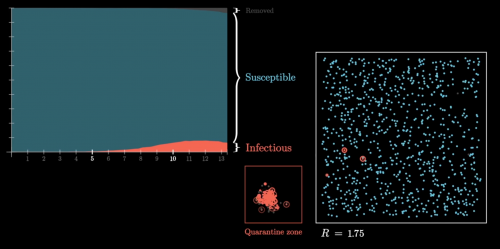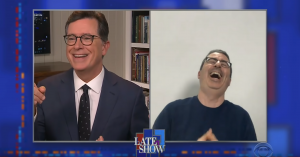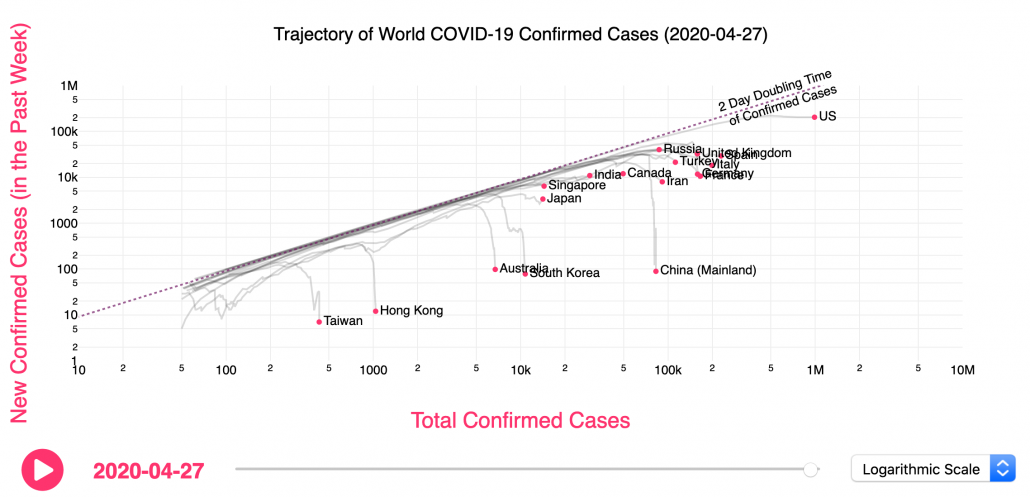A Video Guide to Understanding Covid-19 without Freaking Out
It’s a complicated time, and we’re all emotionally worn out.
Here at emptywheel we’ve covered the current pandemic’s scientific side in some depth. (see Jim White’s look at the origin of the virus, Rayne has done several very good updates on the science, politics, and misinformation,
and I’ve gone into the mechanisms of the disease and how it compares to other pandemics )
But we haven’t done as much for the overtaxed, overwhelmed reader who just wants some pretty pictures and gentle talking heads to make Covid-19 make sense. Even those of you who voraciously keep up with Marcy’s intricate political and media analyses might like to give the emotional roller coaster a break, and still feel like you have some frickin’ idea what is going on.
The Modeling
Nothing is more calming yet informative than 3Blue1Brown’s soothing and surprisingly clear explanation of epidemic models. This 3Blue1Brown explainer uses SIR, a mathematical modeling system for epidemics. While simplified, it can give you a sense for how more complicated models work, and why policies like social distancing and contact tracing are important and effective.
SIR stands for:
S = the number of susceptible individuals
I = the number of infected individuals
R = the number of removed individuals (removed here means no longer infectious, and includes both immune and deceased.)
3Blue1Brown is also one of the most pleasant-to-watch Youtubers of all time. Even when you don’t have any clue about the math he’s describing, it all comes together and you feel smarter by the end. “It’s the mental equivalent of ice-skating,” my daughter says, “You’re a little bit worried about falling over, but it’s nice.”
But why did this happen?
 The why us and why now question is lurking in the back of everyone’s mind, and SciShow comes through on it. SciShow has a long and storied history of well-researched and approachable science education, and their video tackling the zoonotic source of Covid-19 (and other viruses) in bats keeps in the tradition. Bats have evolved different approaches to having a mammalian immune system, which makes them better at handling some of the viruses and worse at handling other pathogens we can overcome easily — this is why their viruses can be so rough on us. We have a lot to learn from them, but we should probably stop disturbing their habitats if we don’t want to keep catching novel viruses from them.
The why us and why now question is lurking in the back of everyone’s mind, and SciShow comes through on it. SciShow has a long and storied history of well-researched and approachable science education, and their video tackling the zoonotic source of Covid-19 (and other viruses) in bats keeps in the tradition. Bats have evolved different approaches to having a mammalian immune system, which makes them better at handling some of the viruses and worse at handling other pathogens we can overcome easily — this is why their viruses can be so rough on us. We have a lot to learn from them, but we should probably stop disturbing their habitats if we don’t want to keep catching novel viruses from them.
The Medicine
If you’ve heard a lot of terms and you don’t know what they mean, Dr. Hope’s Sick Notes goes through 26 of them with clear and non-technical definitions. Dr. Hope is an NHS doctor who teaches and works in an English emergency department as well as a YouTuber. (His ongoing Covid-19 vlog is great, but more stress inducing than the videos featured here.) He gives easy explanations of complicated concepts with handwritten flashcards, a nice soft focus, and some comforting quiet background music. At the end he hands it over to Dr. Sonia, an anesthesiologist at the same hospital, defining some of the more hardcore technical terms we’ve been hearing in the media, but with equal calming friendliness.
 Dr. Sonia appears in our next video as well, as an avid AFOL (Adult Fan of Lego). Dr. Hope and Dr. Sonia discuss how the ICU and ventilation really work, demonstrating with a detailed Lego model built by Dr. Sonia in her day off. It goes over all of the scary terms and procedures and why and how they’re used, but with Lego, so it’s fine. My daughter confirmed this too.
Dr. Sonia appears in our next video as well, as an avid AFOL (Adult Fan of Lego). Dr. Hope and Dr. Sonia discuss how the ICU and ventilation really work, demonstrating with a detailed Lego model built by Dr. Sonia in her day off. It goes over all of the scary terms and procedures and why and how they’re used, but with Lego, so it’s fine. My daughter confirmed this too.
Th ere’s a lot of questions about immunity, herd immunity, and the potential for re-infection, and a lot of misunderstanding about what any of those terms mean. Dr. Seema Yasmin breaks it down on a spectrum from life-long immunity to HIV (The worst). Where and how Covid-19 might fit into this is yet to be found, but she lays down the situation and puts it in context.
ere’s a lot of questions about immunity, herd immunity, and the potential for re-infection, and a lot of misunderstanding about what any of those terms mean. Dr. Seema Yasmin breaks it down on a spectrum from life-long immunity to HIV (The worst). Where and how Covid-19 might fit into this is yet to be found, but she lays down the situation and puts it in context.
And Finally, Something of Less Value
Watching night shows, comedy news, and Youtubers adapt to filming inside their houses has been some hits and a lot of misses, but there’s a few amazing hits. These aren’t so much information about Covid-19 as a few gems life in quarantine has generated. Relax, it’s what everyone’s therapist is suggesting we do.
Stephen Colbert interviewing fellow Daily Show alumnus John Oliver is somehow both unbearable and ten minutes of comedy gold. I wish all late night interviews could be like this, but I also think that would kill me.
 Kate McKinnon takes to a spare bedroom to reprise her role as Barbara DeDrew, trying to get you to adopt a cat, any cat, all the cats, from Whiskers R We.
Kate McKinnon takes to a spare bedroom to reprise her role as Barbara DeDrew, trying to get you to adopt a cat, any cat, all the cats, from Whiskers R We.
Last but not least: what would you say to yourself, if you could travel back to January?
Please feel free to add your own calming and informative, or just funny contributions in the comments, BUT NO STRESS INDUCERS!!!11!!!!!
Um, am I doing this right?
My work for Emptywheel is supported by my wonderful patrons on Patreon. You can find out more, and support my work, at Patreon. Thanks to H.alhajji for the featured image.


